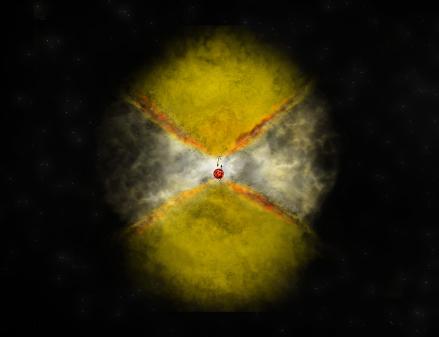Zeroing in on a source of gamma rays

An MSU-led team of scientists has found that gamma rays are emitted from a stellar explosion known as a nova. Where and how these high-energy waves are produced has been a mystery among astronomers. In this artist’s rendering, the yellow depicts the material that is expelled just days after the stellar explosion. Credit: Bill Saxton, NRAO/AUI/NSF.
But now a team of researchers, led by Michigan State University astronomer Laura Chomiuk, has made a discovery that may shed some light on the subject.
Using highly detailed radio telescope images, Chomiuk and her team have pinpointed the location where an explosion on the surface of a star, known as a nova, emitted gamma rays.
This, said Chomiuk, is something they did not expect to encounter.
“We not only found where the gamma rays came from,” she said, “but also got a look at a previously unseen scenario that may be common in other nova explosions.”
The research is detailed in the current issue of Nature.
A nova occurs in a star that is part of a binary system – two stars orbiting one another. One star, known as a dense white dwarf, steals matter from the other and the interaction triggers a thermonuclear explosion that flings debris into space.
It was from this explosion from a system known as V959 Mon, located some 5,000 light years from Earth, that the researchers think the gamma rays were emitted.
This activity was first detected two years ago by NASA’s Fermi Gamma-ray Space Telescope. Also about that same time similar activity was being picked up by land-based radio telescopes around the world.
Since that initial detection by Fermi, which occurred in2012, the spacecraft has detected gamma rays from three additional nova explosions in other star systems.
“This mechanism may be common to such systems,” said Chomiuk. “The reason the gamma rays were first seen in V959 Mon is because it’s closer to us.”
Because the type of ejection detected in V959 Mon also is seen in other binary star systems, the new insights might help astronomers understand how those systems develop.
“We may be able to use novae as a ‘testbed’ for improving our understanding of this critical stage of binary evolution,” Chomiuk said.
Gamma rays can be dangerous and are capable of killing living cells. The medical field uses gamma rays, along with X-rays and other forms of high-energy radiation, to treat cancer.
Fortunately, by the time gamma rays travel across the universe to us, they are absorbed by the Earth’s atmosphere.
Media Contact
More Information:
http://msutoday.msu.edu/news/2014/zeroing-in-on-a-source-of-gamma-rays/All latest news from the category: Physics and Astronomy
This area deals with the fundamental laws and building blocks of nature and how they interact, the properties and the behavior of matter, and research into space and time and their structures.
innovations-report provides in-depth reports and articles on subjects such as astrophysics, laser technologies, nuclear, quantum, particle and solid-state physics, nanotechnologies, planetary research and findings (Mars, Venus) and developments related to the Hubble Telescope.
Newest articles

Bringing bio-inspired robots to life
Nebraska researcher Eric Markvicka gets NSF CAREER Award to pursue manufacture of novel materials for soft robotics and stretchable electronics. Engineers are increasingly eager to develop robots that mimic the…

Bella moths use poison to attract mates
Scientists are closer to finding out how. Pyrrolizidine alkaloids are as bitter and toxic as they are hard to pronounce. They’re produced by several different types of plants and are…

AI tool creates ‘synthetic’ images of cells
…for enhanced microscopy analysis. Observing individual cells through microscopes can reveal a range of important cell biological phenomena that frequently play a role in human diseases, but the process of…





















